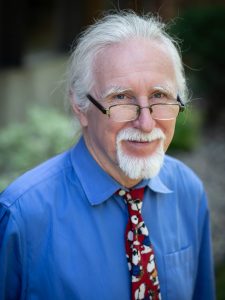 By Bob Hulteen
By Bob Hulteen
Each week when I kneel at the altar for communion, I not only see my beloved fellow congregants gathered near me, I think of those saints who have shared that sanctuary and many others for thousands of years. I also imagine the saints that will follow, perhaps kneeling at altars very different from the one at Holy Trinity. It is the communion of saints that I travel with on my spiritual journey.
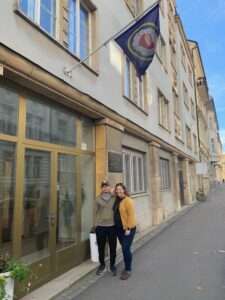
Pastor Aaron Fuller and Kelly Schumacher Fuller at the Lutheran Bishop’s Office in Bratislava
All Saints is and always has been a highlight of the church year for me. It’s a time of the thin veil between the now and the always, where “communing” across time is a near-tangible reality. A time when the boundaries of time and space have little meaning.
“While death indeed has a sting, on All Saints Day we are reminded that the veil is thin.”
This year I was very fortunate to share All Saints Day with Pastor Aaron Fuller and Kelly Schumacher Fuller in Bratislava, Slovakia. Pastor Aaron recently was called to serve at Bratislava International Church, an English-speaking congregation in the capital of Slovakia. Kelly is called to coordinate Young Adults in Global Mission serving in Eastern Europe.
Settled possibly as early as 5,000 BCE, Bratislava has a long and lavish history, especially as a center of the Hungarian Empire in the 16th to 18th centuries. And, the reality of that long history was made real on the evening of All Saints.
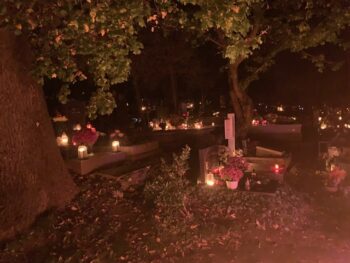
Cintorin pri Kozej bráne
LIKE THOUSANDS OF other residents of and visitors to Bratislava, we were drawn to the cemeteries of the city that night. Walking through winding paths we read the names on headstones, noticing dates that traced back five centuries.
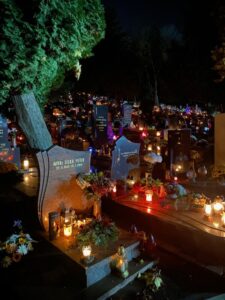
Cintorin Slávičie údolie
We could read the headstones thanks to the candlelight, … as thousands of luminaries decorated the graves of generations of Slovak and Hungarian souls. Who possibly could have spent so much time lovingly attending to the tombs of ancestors five hundred years in the ground?
“In the United States, we so often see death and the feelings of sadness and grief associated with it as something to avoid, to move past,” Pastor Aaron told us. “For Slovaks, and I think it is similar with el dia de los muertos in Mexico, the day is a celebration of loved ones. That is something for us to think about: Death, loss, and grief can be celebrated. It is a way of giving thanks for life that was, life that is, and life that is to come – all in Christ.”
“We could read the headstones thanks to the candlelight, … as thousands of luminaries decorated the graves of generations of Slovak and Hungarian souls.”
While death indeed has a sting, on All Saints Day we are reminded that the veil is thin. We are closer to those we have loved, even those for whom we have no memory, than we can know rationally.
I was probably most struck when Megan Freudenberg, an ELCA teaching volunteer from Texas who has lived in Bratislava for several years, explained the practice with the candles. Indeed, some families adorn the tombstones of relatives hundreds of years gone, since they still reside in the city of their forebearers.
But, Megan went on to explain that some new residents to Bratislava would adopt the tombs of the departed who no longer have family to mind their graves. These new residents faithfully light candles, bringing light to headstones that would otherwise sit in the shadow of living families. I imagine that the new residents find a sense of place and experience home by locating themselves with the history of the departed residents of the city.
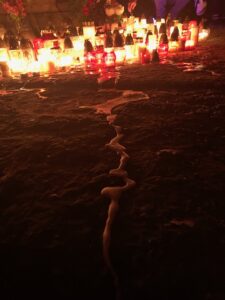
A river of wax
“For Slovaks, All Saints Day is a celebration of loved ones. That is something for us to think about: Death, loss, and grief can be celebrated. It is a way of giving thanks for life that was, life that is, and life that is to come – all in Christ.”
We had first visited a smaller cemetery Cintorin pri Kozej bráne, but then bussed to Cintorin Slávičie údolie, a large cemetery on a hill, occupying many blocks of the city. (Cintorin is Slovak for cemetery.) As we walked into the latter, I noticed a river of wax flowing off the hillside from the thousands of candles trimming the graves.
Such was the faithfulness of the families – old and new – who celebrated the lives of the departed, aware of those yet to come. Such was the commitment to live into a community of the living and the dead. All Saints Day will forever have different imagery for me, and so will my moments of kneeling at the altar to receive the body and blood of Jesus.
